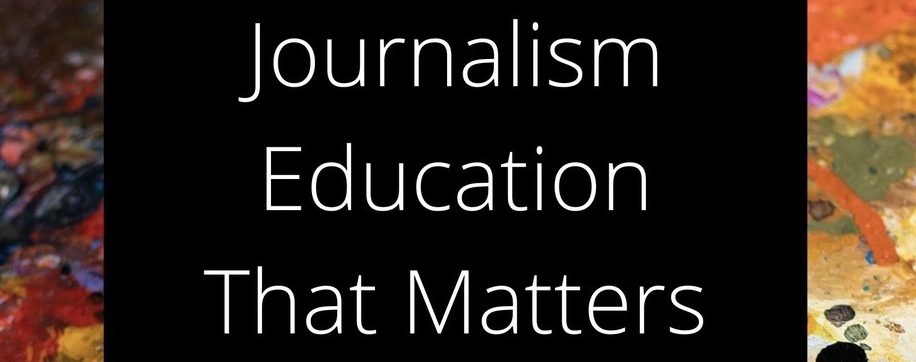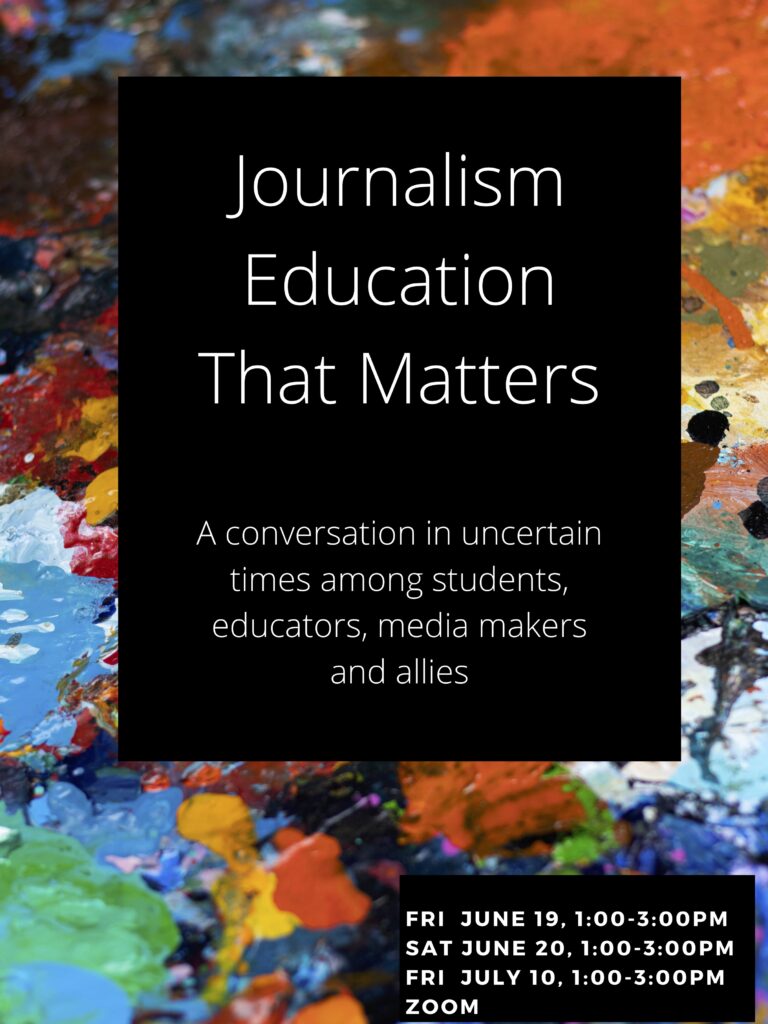
June 19-20, 1-3pm ET
In the midst of upheaval, what’s possible to prepare the next generation of journalists?
Purpose
To create a space for students, educators, media professionals and their allies to explore this question together.
Our aspiration: you discover and pursue promising possibilities.
Agenda
- Welcome/Check-in
- Set the Agenda//Session Bulletin Board
- Breakout Group Conversations
- Closing reflections
- Check-out
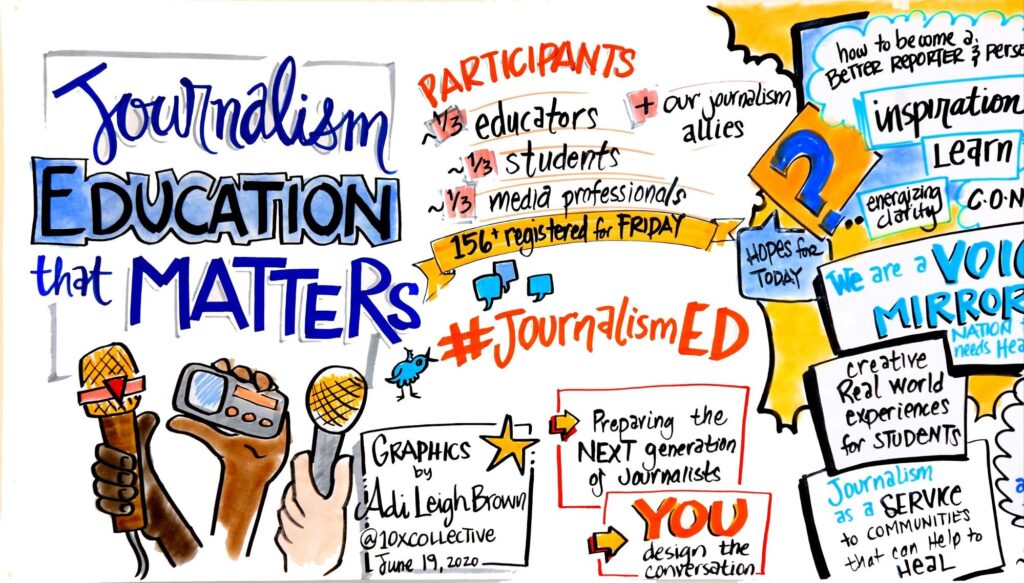
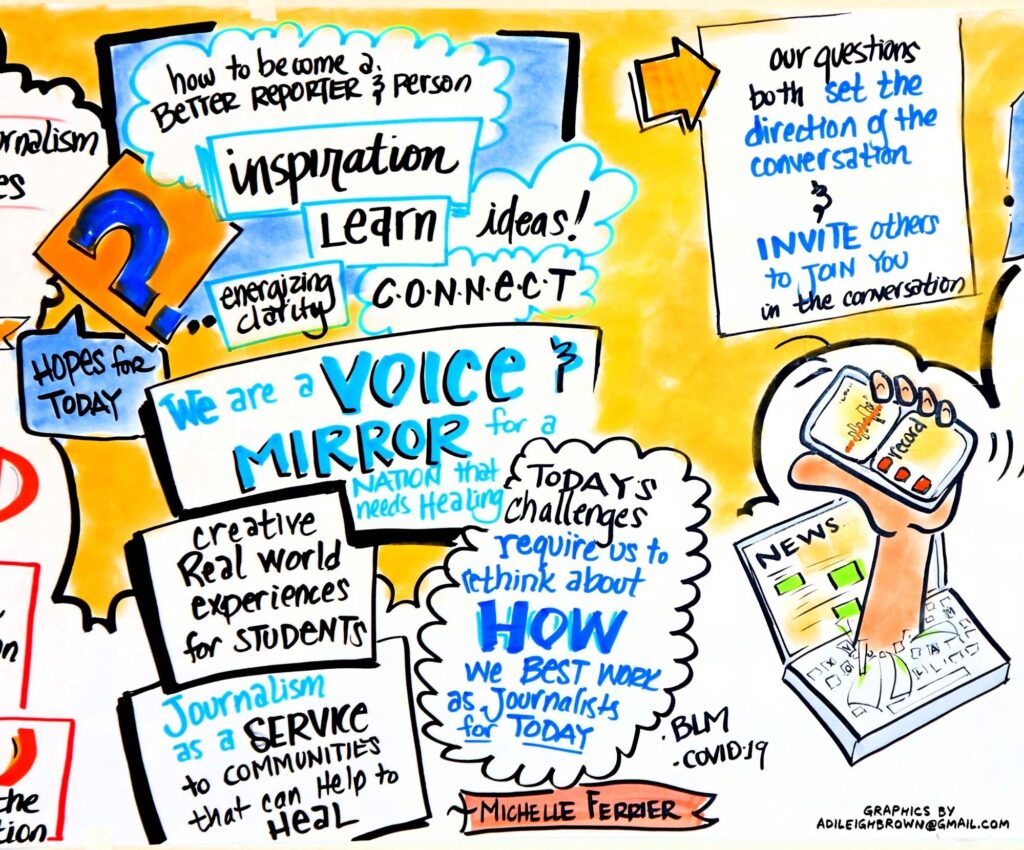
Check-in
In a word or phrase, what do you hope for yourself during our time together?
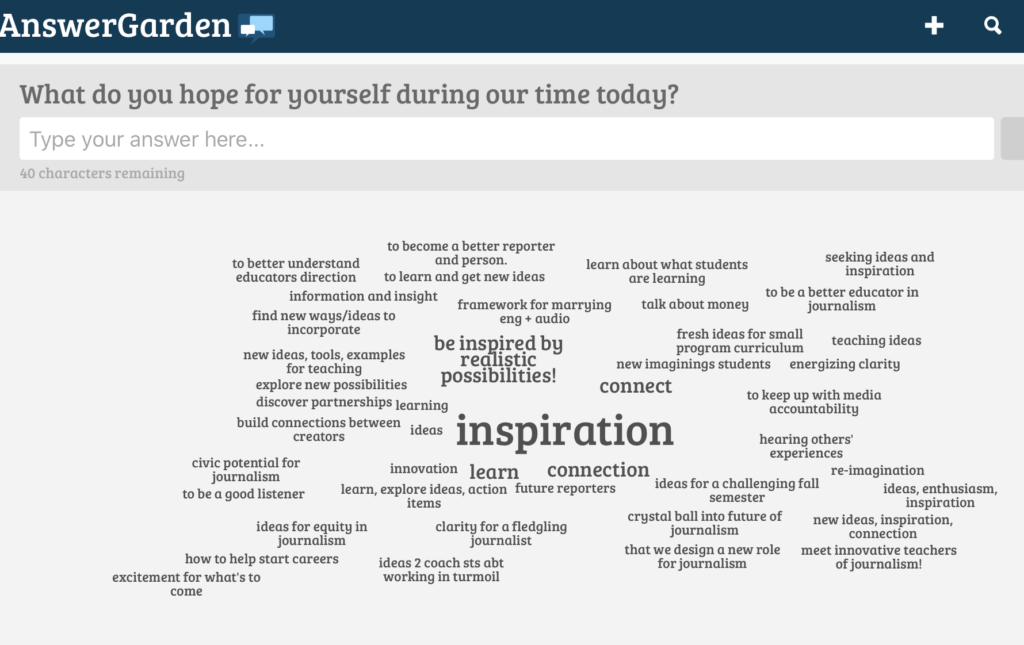
Session Bulletin Board
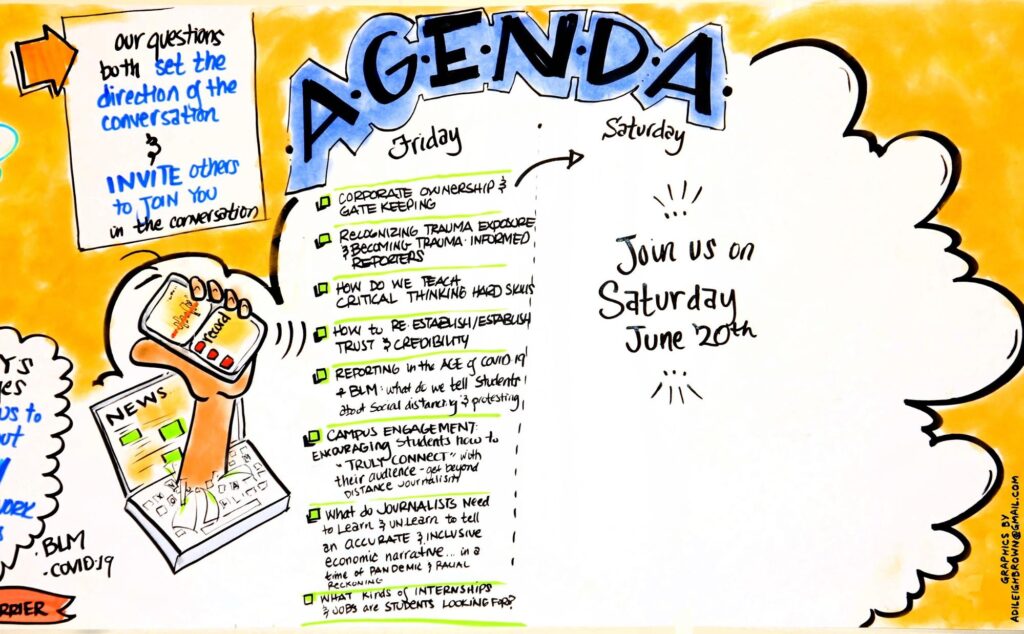
Friday
| # | Name(s) | Topic/Question |
|---|---|---|
| 2 | Kevin | how to help journalist recognize traumatic exposure on themselves and those they report on i.e. become more trauma-informed |
| 3 | John Pettus | How do we teach critical thinking “hard skills? |
| 4 | Mary Ann Owens | How to re-establish trust/credibility |
| 5 | Rachele | Reporting in the age of COVID-19 and BLM: What do we tell students about social distancing, covering and attending protests |
| 6 | Peg | Campus engagement: How to encourage our student journalists to truly connect with the audience – or any small community connection. Beyond the “distanced” journalist. |
| 7 | Linda | What do journalists need to learn and unlearn to tell an accurate and inclusive economic narrative as cities seek to rebuild local economies in a time of pandemic and racial reckoning? |
| 8 | Laura | What kinds of internships and jobs are students looking for? What makes a position or an organization an attractive prospect? |
Closing Reflections
What moved you? High points from your experience today…
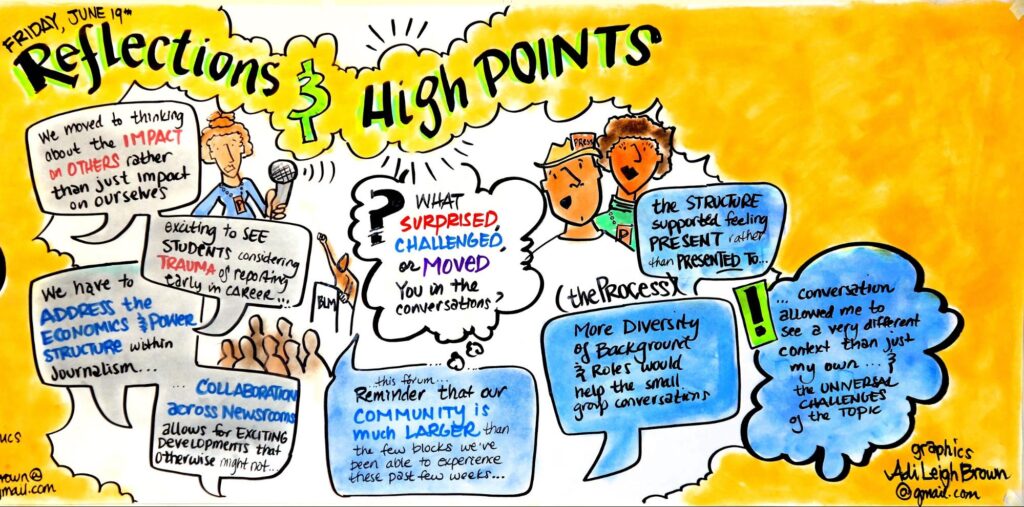
From the chat
From Naima Mungai : Critical thinking is important in journalism, not just for journalists but from the readership as well.
1From Shannon Kennan : This is a GREAT model for doing active learning in the remote classroom.
From Michelle Ferrier : Peg, there’s a book that Peggy Holman wrote on engagement practices: https://www.chegg.com/textbooks/the-change-handbook-2nd-edition-9781576753798-1576753794?c_id=sem&c_id=sem&utm_source=google&utm_medium=cpc&utm_campaign=tb–long_tail-googleshopping_group7&utm_content=PRODUCT_GROUP&gclid=EAIaIQobChMI_eThmMaO6gIVTeG1Ch2rQAD5EAQYASABEgJBGvD_BwE&gclsrc=aw.ds
From Kevin Becker : really like the self-sorting idea. creative and assures active participants
From Rachele Kanigel, San Francisco State University : Ditto what Andrew DeVigal said. So nice to SEE people, even virtually!
From Rachele Kanigel, San Francisco State University : For following up I’d love to see lists of resources, protocols, etc.
From John Pettus : Had a GREAT talk with Naima about critical thinking and *teaching* critical thinking in Africa in a very different context than my own, but also seeing the universal challenges of critical thinking.
From Andrew DeVigal : Yes… to the non-webinar approach. Webinars are good for “broadcasting” info from the “stage.”
From Gina – Fanshawe Journo prof London, Ont. : Thank you! Good conversations – they don’t have to end here.
From Peg Achterman : thank you – serious FOMO on wanting to go to all of the discussions!
Check-out
In a word or phrase, what do you most want to remember from today?
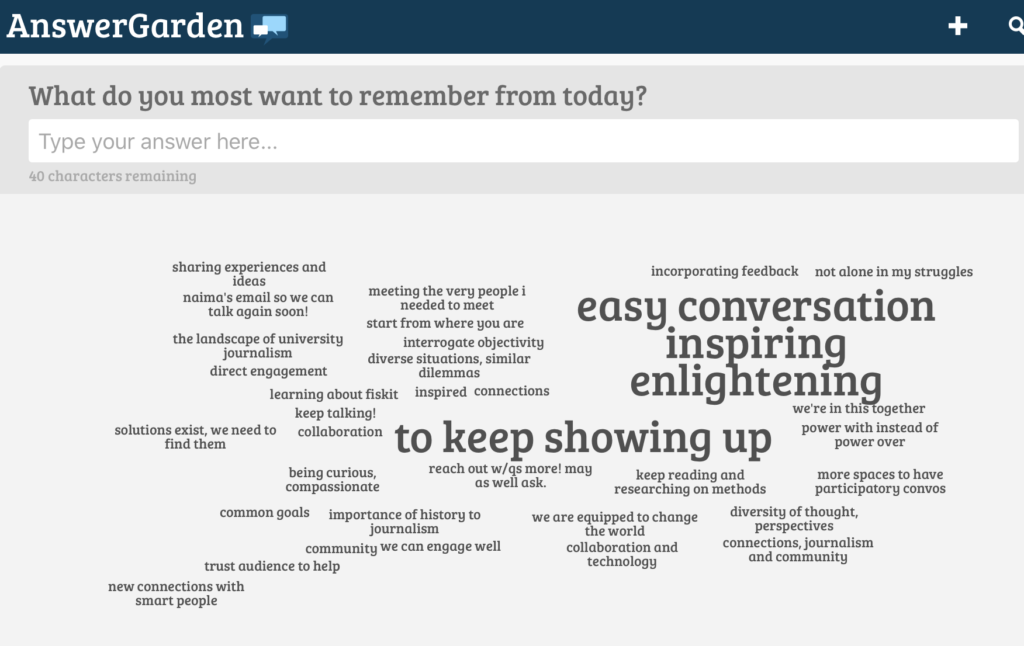
Breakout Session notes
Session 2: Trauma-informed reporting
Host(s): Kevin Becker
Participants:
Shannon
Angilee Shah
Kathy Ou
Regina Lawrence
Michelle Ferrier
Notes
Intro
-Kevin and Lori writing a chapter on trauma-informed journalism in adult higher-ed
-Kevin runs trauma center; has gotten more involved with journalists in last years and pleasantly surprised how many care about being trauma-informed and also how much weight they carry. Has come to think of journalists as first responders with exposure like fire fighters or police. Has become much harder in recent years.
Q: Where can we raise awareness in education? What are the needs in the industry?
Q: Why were you drawn to this topic?
A: Michelle Ferrier, Troll Busters. Educators and managers need to be more pro-active.
Angilee: Journalist and editor. Too many newsrooms have no planning for mental health. It is too often totally ad hoc. For every story we are should breviewing risks.
Shannon: Wrote dissertation around covering school shootings. Need to teach trauma-informed journalism skills.
Kathy: rising junior at Occidental College, Los Angeles. Student journalist, excited about it, but it’s a really challenging time for a starting journalist. When I’ve covered stories, I’ve had the feeling, “Am I exploiting my subjects?” even if they don’t have high stakes. I’m constantly thinking about the relationship between the journalist and the people we are covering. How do you not cause harm or push them to get the information you want and need?
Regina: Studies journalism, saw work of Lori Shontz (sp?). Helped understand student journalists who covered ?? had a traumatizing experience they didn’t know how to process. Workshop on covering white nationalism, talked to reporters who cover protests or embed- spending time with those groups to help us understand them, they come out traumatized, shaken.
Kevin: Everything is so right on target, speaks to the heart of the issues. Police and firefighters are a little bit better, but it’s a perfect example of how an industry that is trauma-facing has learned that not taking care of your people has long-term implications. There’s been a shift; the whole field of trauma has evolved. I’ll never forget when Obama said PTSD in one of his speeches. Journalism is the next among the leading edges. Mental health people are little ahead of police and fire fighters but we have a long way to go too.
Q: Where can mental health intervention be most effective? School or industry?
A: Kevin, anywhere you can start is a good place to start. Kathy had a brilliant question and she will be a great journalist. In newsrooms, policies for mental health plans. Is training and professional development part of what you offer? How much do you expose your staff when you don’t need to? There are a lot of things on a management perspective too.
Michelle: Organizations that bite off doing training for professional journalists. [Angilee: see Dart Center, IWMF HEFAT courses] but not for students, we’re mostly silent with them about the reality of working experience. Train on how the digital environment has changed how we work. It really is changing how we have evolved in journalism; professional culture people won’t speak up. They won’t share it with managers, colleagues. We a triggered to go into hyperdrive but we have cultivated a system like Hollywood and film studios with stars. Before social media, we were able to operate with some anonymity but we have combined star appeal for individuals rather than brand that has created significant friction. The journalist is the target of the attack rather than the organization. What makes sense? Not putting a byline on a story? “Staff reports.” Can create a problem for transparency but we can use it to mask and protect ourselves.
We don’t talk about the secondary effects of the stories, that people have to live with the stories that we write. How do you measure positive and negative impact? Following back up and finding out what happened, not being extractive “drive-by journalism” but being in relationship with them. Take time to honor what they’re giving you. Speaks to today, covering up face of protestors and how we offer anonymity.
Shannon: Found in dissertation, went to site of school shooting year and a half later. The thing that affected the kids, school, families more than anything were the shady things reporters did to try to get the story. Some of them truly were unconscionable, like pretending to be a relative to talk to mom of kid in surgery. One reporter was young and admitted to making mistakes because he was ambitious, saw the story as way to get next position. Editor called him a “stallion” – published rumors that weren’t true. We have to send people who can recognize trauma.
Q: Regina: Michelle used phrase “ripple effects” – if journalists are trained or supported to care for themselves, they aren’t going to be aware in dealing with traumatized communities.
A: Kevin: When I started doing this work, at trauma clinic, balanced caseload of child and adult. Then few months had first child and had trouble doing work in child cases. Noticed changes in comfort level, told supervisor. She said, “You’re learning about where you should work and what your emphasis should be.” Shifted focus not completely but toward more adult and community stuff. If we don’t know blind spots or “allergic reactions” — if you’re trying to understand and retell the story — if not sensitive to your stuff and their stuff, you’ll miss a lot and run a greater risk of doing more harm.
Kathy: If you’re not sensitive to the material, you run the risk of doing more damage. Covered a recall campaign, parents were furious and I was reading all the articles online. Overwhelming information, but obliged to understand the sides, but it’s a lot so it’s hard to get a complete grasp. At what point is enough to get comfortable to go in and talk to people? It seems like there is no end to knowing an issue.
Michelle: You cannot be an expert on everything you cover. You don’t have to go in knowing everything, you just have to go in with good questions that sometimes requires that background reading. Early in career story: youth and AIDS, read stack of reports and materials to set up a series of questions. Asked in interviews, who is the next person I should talk to? And I may come back to you. You can’t know the story before you talk to the sources, unless you’re synthesizing material.
Angilee: A Lot of j-school panels. It was hard for me. So many students were so excited, a person of color and appreciated how excited students were to have that kind of role model. At the same time, very few moderators in the room asked was it worth it? Was it worth it for your safety? Safety of others? There are a lot of things that I want students to know before they do that kind of coverage. People need to know if they are taking a risk, there is editorial value. It is a big commitment to witness violence.
Michelle; journalists of color can bring a different perspective and understand more viscerally what’s going on at present; also a responsibility to train wider group to ask better questions and tell the story accurately. How do we do journalism intersectionally?
How does that became the norm in training circles.
Angilee: Journalists of color as war correspondent. I don’t regret my career. People literally asked me questions “That’s so exciting.” It wasn’t exciting. A lot of sit around and wait and then seeing very terrible things. It’s more than a decade and yet, it is still with me and it piles up over time. They need to reframe– not as heroic work. It’s going to take something from me to do this.
Kevin: Being trauma-informed, means your reporting can be therapeutic. It’s therapeutic when you’re accurate. If someone feels you are telling their story in an accurate way, that can be therapeutic.
Regina: Active listening (Ripley?)Relational skills; aspects of interviewing and writing. Emphasis
Shannon: Editors fully recognized what reporters were going through? Guided reporters to their own mental health. I really walked away flabbergasted at how well (school shooting) it did have parachuting journalists. But I was amazed and in touch the two news editors were and how they led their team. TV crews that covered it as well. One TV reporter on the scene first, described the scene as alone, intimidating and fully aware of her presence and the impact of the work she was doing. Tie to community.
Session 3: How do we teach critical thinking?
Host(s): John Pettus, Naima M
Participants:
Notes
Critical thinking is not taught enough across Africa (or anywhere)
Overview of Fiskkit tool for examining articles line-by-line and thinking about fact, logic
and rhetoric
Need to teach young journalists to examine their OWN biases as they learn to think about journalism
Examining biases comes from back and forth conversations between student journalists and teachers and each other
It can help to insert additional context to articles, especially in media environments with state controlled media
How do you get journalists to identify their biases and apply critical thinking to their stories. – Frequent communication (feedback loop with continuous exercise) to get them to learn better.
Main points when teaching critical thinking
- Do it multiple times
- Article selection for teaching is really important during the conversation
- Importance of tech when teaching to measure retention and understanding.
- The population/ readers need to be involved and the process will let them also be educated in critical thinking looking at news stories.
Session 4: Establishing trust and credibility
Host(s): Mary Ann Owens
Participants: Mary Ann Owens, Karen Magnuson, Lydia Hansen, Sarah Murphy, Zee Ngema, Lauren Xie
Notes: by Karen Magnuson (with assistance from others)
–Mary Ann set the table on the erosion of media credibility.
–Lydia, a recent graduate, is looking for advice as she looks for a job in journalism. Concerned about the issues regarding credibility in the industry. Seems to be more credibility associated with print. Knows how to build connections through social media.
–Lauren is from Lively Worlds, an organization that is an ally. She believes there is a need for journalists to produce work that is more relevant — especially systemic change. Must reflect communities.
–Sarah, who is with the Kettering Foundation, a research organization focused on what makes democracy work as it should, says some of the research with journalists looks at rethinking the role of journalists and how they can work with the community to solve problems. What would it look like if we see people more than just readers, but as users. “We can both learn from each other.” Noted Spaceship Media and its work with media deserts.
–Zee is studying social journalism. More focus in the U.S. on being first than being accurate. Financial incentive to being first, especially in corporate-owned newsrooms.
–Lauren: Should we revisit the way journalism is funded?
–Karen: Solutions J project manager* – worked for Gannet* for 20 years – experience with newsrooms is that it’s both – need to be urgent but great emphasis with investigative journalism – a greater push to do more investigative journalism – needs to be a blend – connecting with community to go deeper on stories of NB importance — need to revisit how journalism funded — a lot more nonprofit newsrooms not only surviving but thriving; a lot of credibility — pro publica is fair and great example of what journalism can look like. SJN is a nonprofit based in NYC — work with newsrooms to train them on SJ —
–Sarah asked: what are the concerns of students? Mary Ann: my students are disheartened. Some not planning to go into journalism. Few jobs out there. She tells students to gather facts and share info without passion or prejudice. Everyone was unprepared for covering the pandemic. Blames corporate culture and ownership for the mess the industry is in.
–Lauren: can there be a case made for journalism to be funded by the public? Mary Ann: yes, NPR an example, but issues with orgs such as Voice of America.
Session 5: Reporting in the age of COVID-19 and BLM
Host(s): Rachele Kanigel
Participants:
Teresa Puente
Gina Lorentz
Ashley Kang
Ricardo Gabriel Go
Lori Shontz
Kim Fox
Jade Stewart
Notes:
-Revamp and decisions on the fly. Always told to get out there and get as close as you can, but now it’s the “new now’ and questions about what we tell students and their assignments. Now vs. future (in-person).
-Civil unrest questions. What to tell students about political activism.
-Gabriel: changing role of journalism. Moderator: Advocacy and activism vs. neutrality and objectivity.
Q: What are you telling students about protesting vs. covering?
-People are not objective, but have to acknowledge values and beliefs and if I’m reporting on an issue how do I get various points of view. But on racism or other matters, you don’t have to go to the extreme to get the other side. Is that responsible to get polar opposite? (no).
-When it comes to students protesting, there are journalists who have advocated on issues. But, what type of journalist do you want to be? Advocacy or NYT with Ethics and Standards.
-Journalists can make a difference within conversations. A public service rather than personal creative outlet. A lot can be learned for what was done previously. Ida B. Wells.
-We need to rethink the message of reporting and what they can cover. Student choices in what they can do… but giving a lot of information regarding public health. If you’re considered at risk to self or others then here are alternatives.
-Alternatives: Setting up interviews for them? (e.g. athletes come to class). But then controlling the story.
-What face to face experience can they get? Found that students didn’t back down. Interesting stories from students interviewing family members (oral history, life experience). Students got creative using WhatsApp for audio assignments. They’re willing to test different things. (list of options provided and it was trial and error – tried out the tools and evaluating) Knowledge was shared.
-Before lockdown – students were interviewing journalism students in Bulgaria written (from Cairo audio)… class session about options to gather audio remotely.
-Told not to do face to face… magazine did audio/video calls instead. Photographers no, but illustrations used. We will probably do shoots again this summer, but creating specific guidelines in a safe way. What can be done remotely and what NEEDS to be done in person. This is to help develop protocol. Technology allows remote interviews.
-Other editors/newsrooms consulted to create reporting guidelines.
-Best practice reporting policies? Best audio, best video, in-person allowed (how)
-Gained access to people who wouldn’t have been available for classes otherwise.
-Better tracking gained through this experience and working independently.
Session 6: Campus engagement – How to encourage our student journalists to truly connect with audience – or any small community connection. Beyond the “distanced” journalist.
Host(s): Peg Achterman
Participants: Erik, Andrew, Alisha, Elia, Serafin, Joe, John-Erik, Marina, Kim, Shannon
Notes
- Traditionally antagonistic role between students on campus and student journalists
- Listening sessions with the campus?
- Asking students what they want to hear from student publications
- Student journalists are part of the community, but still feel separate
- How do we establish formal practices for building trust and connection between campus communities
- Once a quarter – bring students in to ask, “what do you care about?”
- A learned skill – establishing community connection
- Is there a culture of students showing up to community events?
- Is there a good time for this? Maybe pairing it with other large events on campus
- Is there a way to foster this involvement digitally?
- How do we adjust these practices of engagement based on the size of the university
- What are the perceptions of student journalists on campus?
- Faculty
- Students
- Potential solutions
- Elia – Group projects, text their questions
- Text responses – finding easy ways for students to engage digitally
- Andrew DeVigal –
- facilitate community conversation – students come with story questions (ie: Flux Magazine)
- Follow up with conversation at the end – Did we get this story right?
- Asking students about their information needs (ie: Info Needs Assessment with La Pine)
- More resources on Gather
- How do student journalists engage with the community in such a short time period?
- Finding continuity for students even if student journalists graduate
- Marina Hendricks
- Beats specific to smaller local communities – agricultural beat
- Social media presence – showing accomplishments and developments
- Trusting News
- Community outreach – our campus community and local community:
- Example 1: Teri Finneman/University of Kansas/Eudora Times https://www.poynter.org/reporting-editing/2020/this-citys-only-local-news-comes-from-college-students-now-most-of-them-are-covering-covid-19-from-their-childhood-bedrooms/
- Example 2: Gillian McGoldrick, Temple University journalist
https://twitter.com/gill_mcgoldrick?ref_src=twsrc%5Egoogle%7Ctwcamp%5Eserp%7Ctwgr%5Eauthor - John-Erik Koslosky
- How do we promote engagement in rural communities and college towns?
- Andrew DeVigal
- Partnerships with existing organizations and student organizations on campus to host conversations
- Online announcements and flyers
- Encouraging other orgs to bring their constituents (What will they get out of it?)
- What is under-reported, what stories are you hearing that we’re not covering
- Community and student leaders can become your advocates
- Programs that can be helpful for hosting the conversation
- Open Space Technology
- World Cafe
- Zoom
- Elia Powers – Finding a happy medium between hosting an in-person meeting and simply texting response
- Erik Palmer – options to generate more conversation-based opportunities
- Discord +
- Slack
- Joe Guvendiren – Need to find ways to promote engagement
- Fiskkit – program that will allow people to engage in real time with published material
- How to minimize trolling – no one can be anonymous – requires validation through another platform
- Higher bar for engagement – expect civility
- Erik Palmer
- As part of term – Assignment where students devise an audience engagement event
- Gathering feedback that can be compiled in one place
- Finding connections between journalism-minded students and marketing minded-students
- Elia Powers
- Using programs like Fiskkit to crowd-source and help student reporters build a story
- Joe Guvendiren
- Fiskkit classroom – private platform where classes can peer-review work
- Ways to measure engagement and patterns of editing
- We need to find ways to get feedback and build stories using the technology available to us
- Peg Achterman – thinking as writing, writing as thinking
- Finding connections between departments
- Working with the political science department to cover the election
- Listening to those on campus who know more about specific topic about how to do better in covering these topics
- With so many online programs that can help foster community engagement, is there a way to centralize these resources?
- Campus publications don’t have to just be run by journalism students
- Business students can help
Session 7: Telling inclusive economic narratives
Host(s): LInda Miller
Participants: Abe Kenmore, LInda Miller and Peter Pula, Katrina Janco
Notes
What do we have to learn … maybe civil society and governments who save money when journalism makes its contribution are our new customer.
How does the economics of newsrooms impact how newsrooms think about and report on the economy? Starting from college newsrooms and going from there, the inequality begins there since students who are able to build portfolios and get clips work for free for years. Students who have to work throughout college don’t have this opportunity and it screws them for the future because they don’t have experience. Also a huge Catch-22 situation for entry-level journalists overall.
Journalists not knowing the history of communities and economies leads to poor coverage of the economy, wind up lifting single people instead of thinking about systemic issues with the economy.
Consider how overworking journalists makes news more reactive and not proactive.
Maybe to pivot away from re-illuminating the institutional stories again and again to focussing always on the stories on the ground that are directly relevant to the agency and ability in a community itself to shape the community as they would like to see it shaped. And not focus on unicorn/the exception to the rule stories.
Who informs the stories? Why is it always institutions?
Oscar Perry Abello at nextcity.org
Luxury vs necessity City Bureau piece https://www.citybureau.org/notebook/2019/7/17/journalism-is-a-luxury-information-is-a-necessity
To deeply democratise our newsrooms themselves
Session 8: What are students looking for in jobs and internships?
Host(s): Laura Fillbach, ideastream public media (Cleveland)
Participants: Doug Mitchell, Next Generation Radio; Alisha Savson, Zee Ngema, Ambar Castillo, Lydia Hansen
Notes:
Doug teaches students how to create non narrated audio stories (Story-Corps style) with a mentor who teaches students how to craft a story. They work with illustrators and visual journalists, also learn technical tools. There is now a community of several 100 who have mentored or been students in the program.
There are too many of the same kinds of stories that sound the same kind of way, and less value is often placed on non narrated stories that feature only the voices of the subjects. But these stories are done very intentionally in order to teach how to build trust and tell stories in a different way. They think about “who goes into a story?” and “what goes into that?” And students are getting jobs after going through this program.
So many universities are still teaching how to do TV stories.
Laura wonders if there’s a disconnect between what students are looking for and find compelling and what orgs are offering and how they are putting themselves out there? How should legacy orgs rethink how they present themselves, meet the future with open arms?
Alisha is a nontraditional student in a j-program but doesn’t exactly consider herself a journalist. Focus has always been on community + storytelling. (For internships, emphasize both what the duties are / what the project is and how the internship lead will mentor and support the student’s growth. If you are creating internships to grow students–and not just fill a job gap at your organization–share what your mentorship philosophy or approach is in the job description.)
Bringing engagement into journalism is still a highly conceptual thing.
Project Blueprint from NPR Training is a great resource that is a design thinking exercise to think about what people want. It’s important to understand audience.
Some of Doug’s students are not interested in the news, but that’s “the news as it’s presented, not the news itself”
Zee is a student at grad school in CUNY, NY, but she’s not from the US. Sometimes the language can be isolating and make you feel like you aren’t as qualified as you potentially are. Taking the time out to communicate better and more openly would be very advantageous for both parties. Applications could be more inviting and conversational, comforting. It’s a scary process – we all have imposter syndrome, but if we feel there is freedom to learn and teach that would be really helpful.
Doug tries to make sure the messaging for his program is inviting and inclusive with every promotional message. If it doesn’t have a person of color in it, it’s not going out
Ambar is doing an internship with Story Corps right now and she’s seeing more of a shift toward non narrated stories.
J-school thinks of “community engagement” differently – metrics vs. talking to people/elevating source voices
Lydia is looking for jobs right now. When job descriptions don’t really explain what the job is that is a turn-off. What expectations do orgs have and how can you tell if that’s aligned with your skills and interests?
It’s hard when orgs use “buzzwords” to know if the culture really matches the words they’re using.
Often the language we use to advertise roles is designed to attract the same kind of people.
Is there a way to start a trend where the language IS designed to attract a more diverse, inclusive set of candidates?
In school we’re often taught a very specific process for creating work from idea → product, but not necessarily how to engage with people and include them in the process
